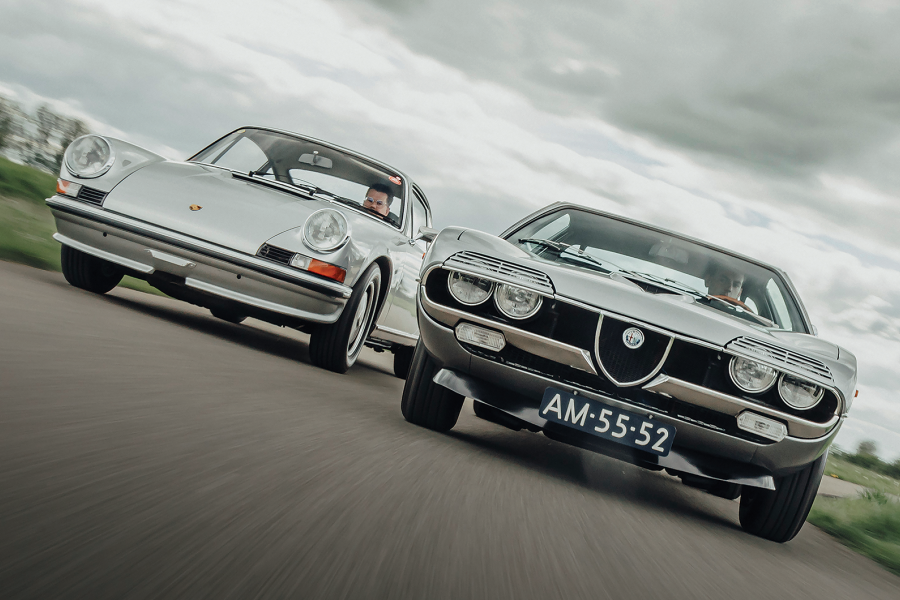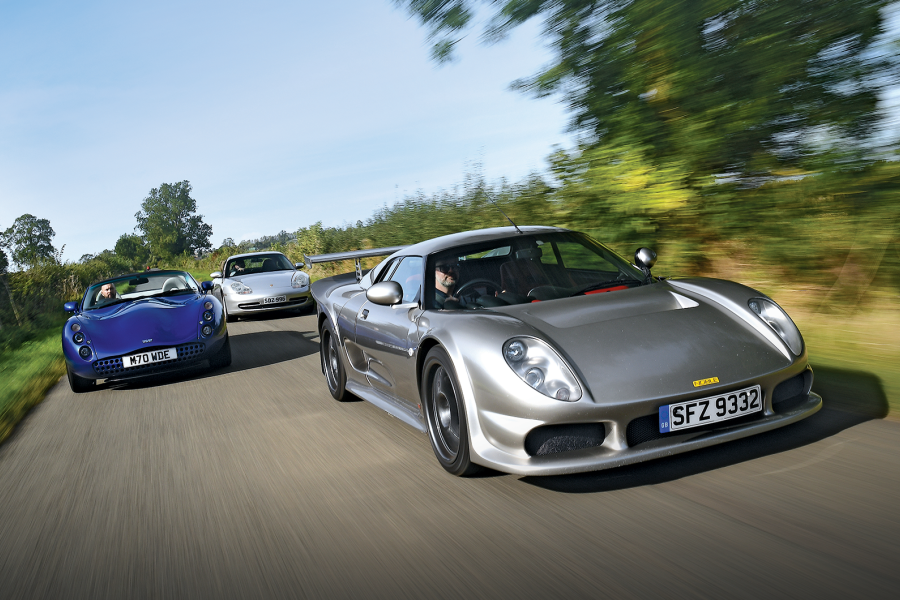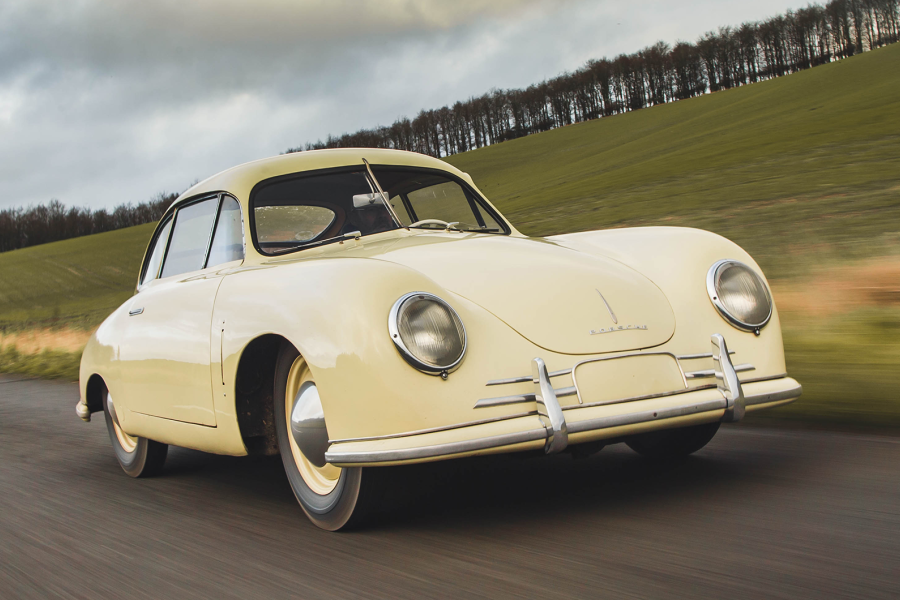Ironically, the eight-cylinder engine was turning out to be the least troublesome part of the package.
‘The interior of the W-RS is Minimalist, but surprisingly comfortable’
With Porsche not taking its prototypes to Le Mans in 1962 due to the organising Automobile Club de l’Ouest being a law unto itself and only accepting GT cars, not prototypes, the Coupé wouldn’t race again until 1963, but the W-RS had a more intense off-season, competing in selected rounds of the European Mountain Hillclimb Championship, plus a six-race campaign in North America.
This yielded valuable feedback, not all of it positive, and compelled Porsche to make numerous design changes for 1963, including new doors and decklids made of glassfibre (an innovation that supercharged the development of the forthcoming 904), as well as a move to coil spring and wishbone suspension – something that would mark a historic, and permanent, move away from parallel trailing arms.
And what did all of this effort net the W-RS? Well, if the record books are to be believed, a lowly seventh place at the 1963 Targa Florio after transmission failure left the car with just one gear for the final lap.
The Porsche’s three-spoke Bakelite steering wheel provides plenty of feedback
However, this doesn’t quite tell the whole story.
Because, once again, the Coupé, benefiting from the upgrades that came out of the W-RS international testing programme, took up the Porsche mantle and ran ahead with it, as Bonnier brought the car home first overall, earning the Type 718 what was arguably its greatest-ever victory.
In subsequent years, the Spyder continued to make appearances on the international stage, where it acted as the ultimate team player but seldom basked in the limelight.
Not that this was seen as a great tragedy by the engineers at Porsche.
Porsche 356 rear lights on this 718 W-RS racer
The development of the 904 was already under way and the W-RS had, in effect, served its purpose, demonstrating the worth of disc brakes, glassfibre panels, a rear wing to counter drag (implemented at Le Mans) and the eight-cylinder Type 771 engine – a unit that would go on to feature in everything from the 906 to the 909 Bergspyder.
So it is perhaps unusual, then, that it was during this period, away from the international stage, that the W-RS became something of a legend (at least in the halls of Zuffenhausen) in the hands of Edgar Barth.
No stranger to the Type 718, having won the 1959 Targa Florio behind the wheel of a 718 RSK, Barth was entrusted with wresting the European Hill Climb Championship from the grasp of Ferrari and its nimble Dino 196SP.
The Porsche’s slim, glassfibre doors are opened by pull-handles on the inside
It would have been easy to dismiss the tall, balding 46-year-old Barth, especially when the chiselled, dark-haired reigning champion Ludovico Scarfiotti was just 29.
But Barth was a natural at hillclimbing, having won the championship in 1959.
With the W-RS by then producing 240bhp, he proved unstoppable, winning six of the seven climbs in 1963 and five out of seven in ’64, which crowned him king of the mountains two years on the trot.
Tragically, Barth passed away from cancer the following year, prompting the decision to retire the car from motorsport out of respect.
‘Porsche went all-in with new technology’
This marked the end of four years of intense competition and a total of 32 event entries, a longevity record that earned the W-RS the affectionate nickname of Grossmutter, or Grandmother, among the Porsche mechanics.
While this car may not share the same level of fame as its predecessors, the 550 Spyder and 718 RSK, nor its successor, the 904, perhaps we can take solace in the fact that it is respected by those who truly matter: its custodians.
Images: John Bradshaw/Porsche
Porsche 718 W-RS: driving Grossmutter at Goodwood
The Porsche 718 W-RS quickly inspires confidence on Goodwood’s wet and slippery hillclimb course
Roy Salvadori famously said: “Give me Goodwood on a summer’s day, and you can keep the rest,” but I suspect today’s relentless deluge would dampen even his enthusiasm.
It’s Friday at the 2023 Goodwood Festival of Speed, the day before a severe wind warning will call the event off for the first time in its 30-year history, and we’re huddled in the drivers’ sign-on tent.
Just climbing into the W-RS is an experience. You instinctively reach for a doorhandle, as you would on any other 718, before remembering that they were removed, ahead of the 1963 season, to save weight.
Instead, reach over the glassfibre door and open it from an internal latch, then throw your right leg over the broad sill and stand on the seat before sliding in.
The interior of the W-RS is Minimalist, but surprisingly comfortable.
The thin, three-spoke Bakelite steering wheel comes out to meet you, the empty door recesses give loads of elbow room and the impossibly low windscreen affords unimpeded vision.
Or at least it would if it weren’t raining so heavily.
As we depart the assembly area and head towards the startline, the rain intensifies and I spend the next minute or so fiddling with my visor to stop my glasses steaming up – a useful distraction from the fact that I’m about to guide the one and only W-RS in existence up a narrow, soaked piece of Tarmac.
In my head, I know the optimum way to get the car off the line is to give it a bootful of revs, sidestep the clutch and let the rear wheels spin.
But I can’t quite get the weight of its history off my shoulders, so decide to gently dribble away from the line.
And instantly regret that decision: the engine bogs and, no matter how much gas I give it, our speed slows to a crawl.
Although its GTR Coupé siblings are no more, the 718 Spyder is still used by Porsche
Trying not to panic, it’s time to revert to a more robust approach: dial up plenty of revs and then drop the clutch.
The engine picks up and fires the car towards turn one with gusto, as if to say: “I won two hillclimb championships – man up and get on with it!”
Grip is limited and the steering slow, but the feedback is quite unlike anything I’ve experienced.
You can immediately feel how much adhesion there is to play with through the thin-rimmed steering wheel, and you can sense the car moving around underneath you.
Confidence goes from rock bottom to through the roof within around 300m, with the 718 encouraging you to get hard on the throttle out of turn two and down the closest thing the course has to a straight.
The brakes require a lot of pressure into the infamous Molecomb corner, but from there it’s a short squirt up to the flint wall and then down from fifth to third gear.
The six-speed gearbox was confusing to newcomers in period, but it’s a joy to use, with a light and precise lever, and pedals positioned just about close enough for heel-and-toeing.
Two more corners to go.
These are notoriously greasy bends due to the overhanging trees, but the W-RS dances through the right-hander and feels stable through the more gentle left.
With one final burst of power to bring us across the line at the top of turn six, I try to take in my surroundings and enjoy the guttural wail of the 2-litre flat-eight sitting just behind me.
What an experience. What an honour. And what a way to discover that the Grossmutter remains one of the most underappreciated Porsches of all time.
No wonder they couldn’t retire it.
Enjoy more of the world’s best classic car content every month when you subscribe to C&SC – get our latest deals here
READ MORE
Porsche 917: flat-out flat-12
Future classic: Porsche Boxster 25
25 cars Porsche never built

























